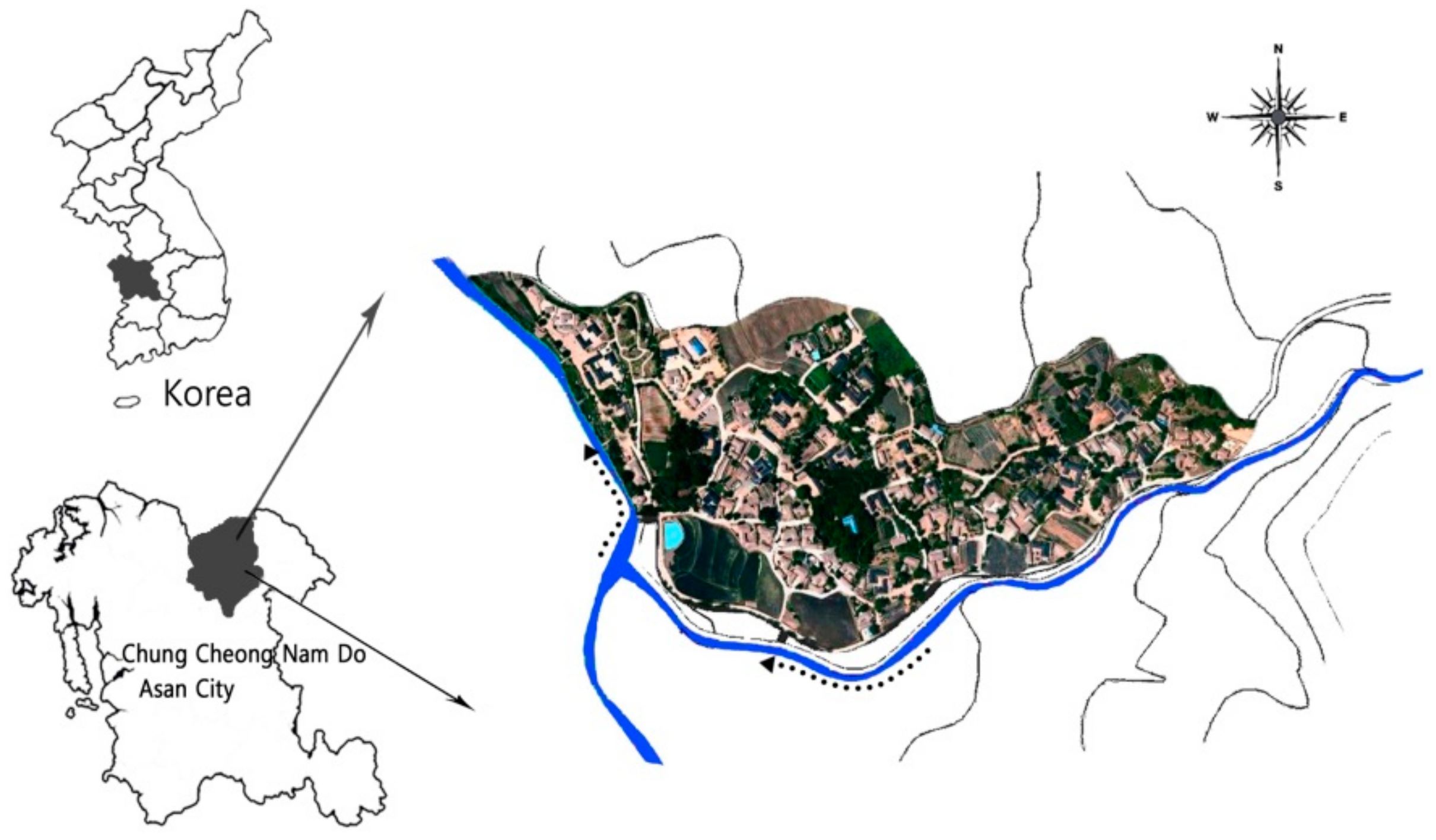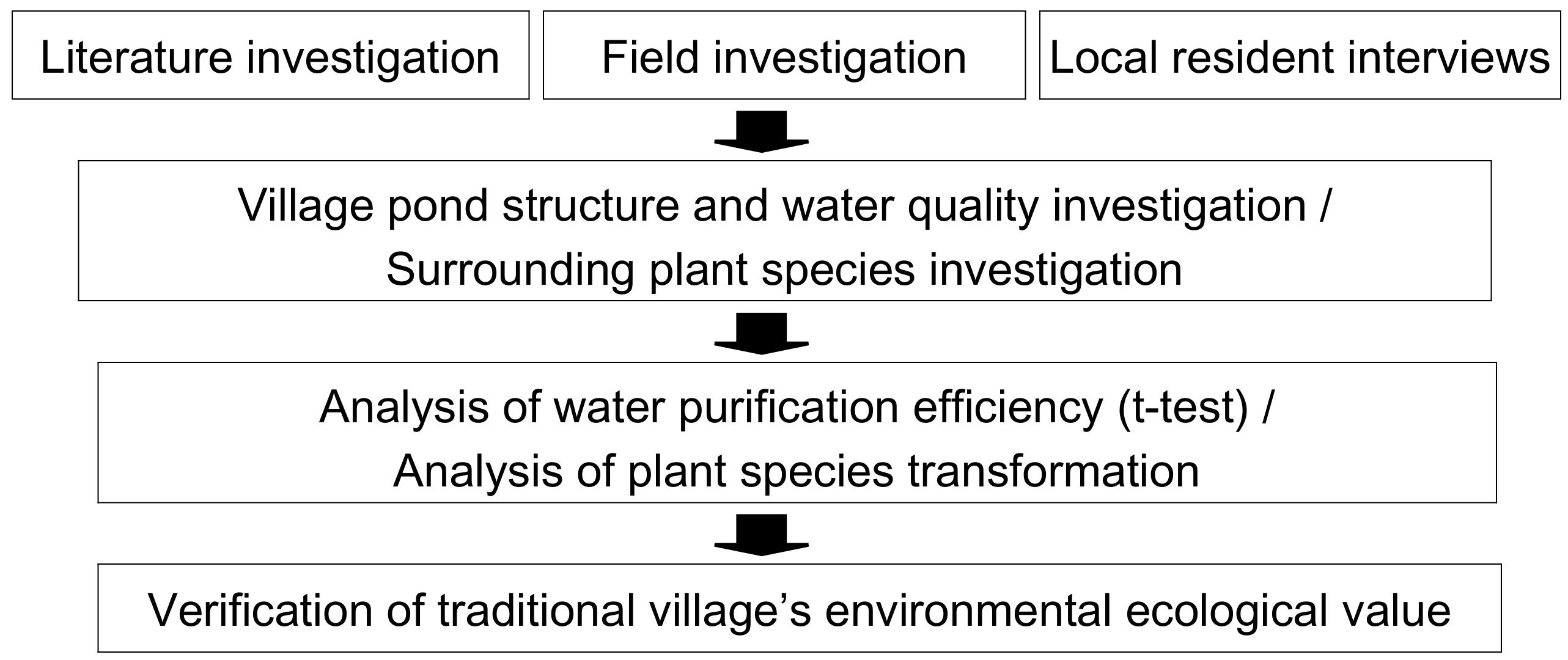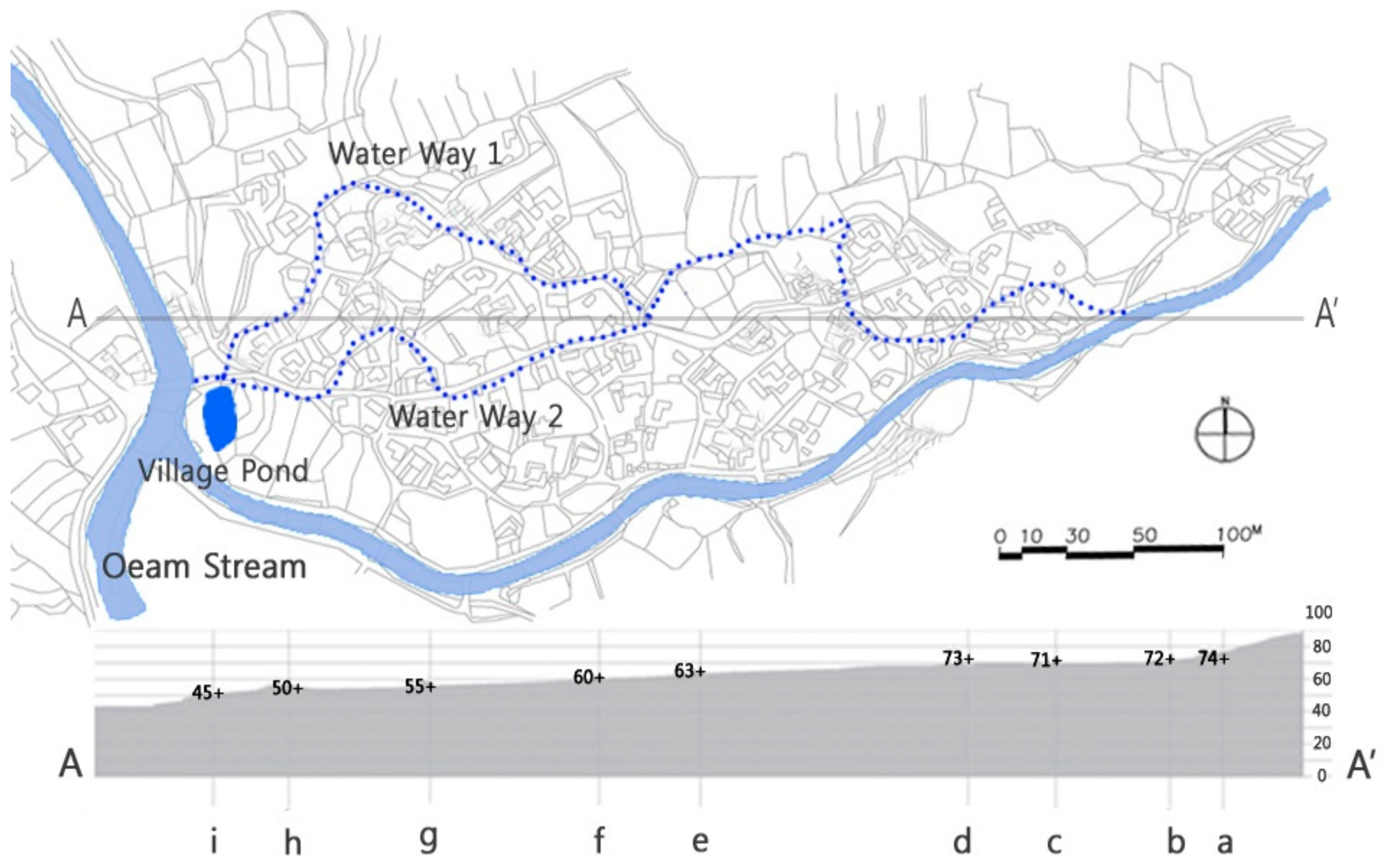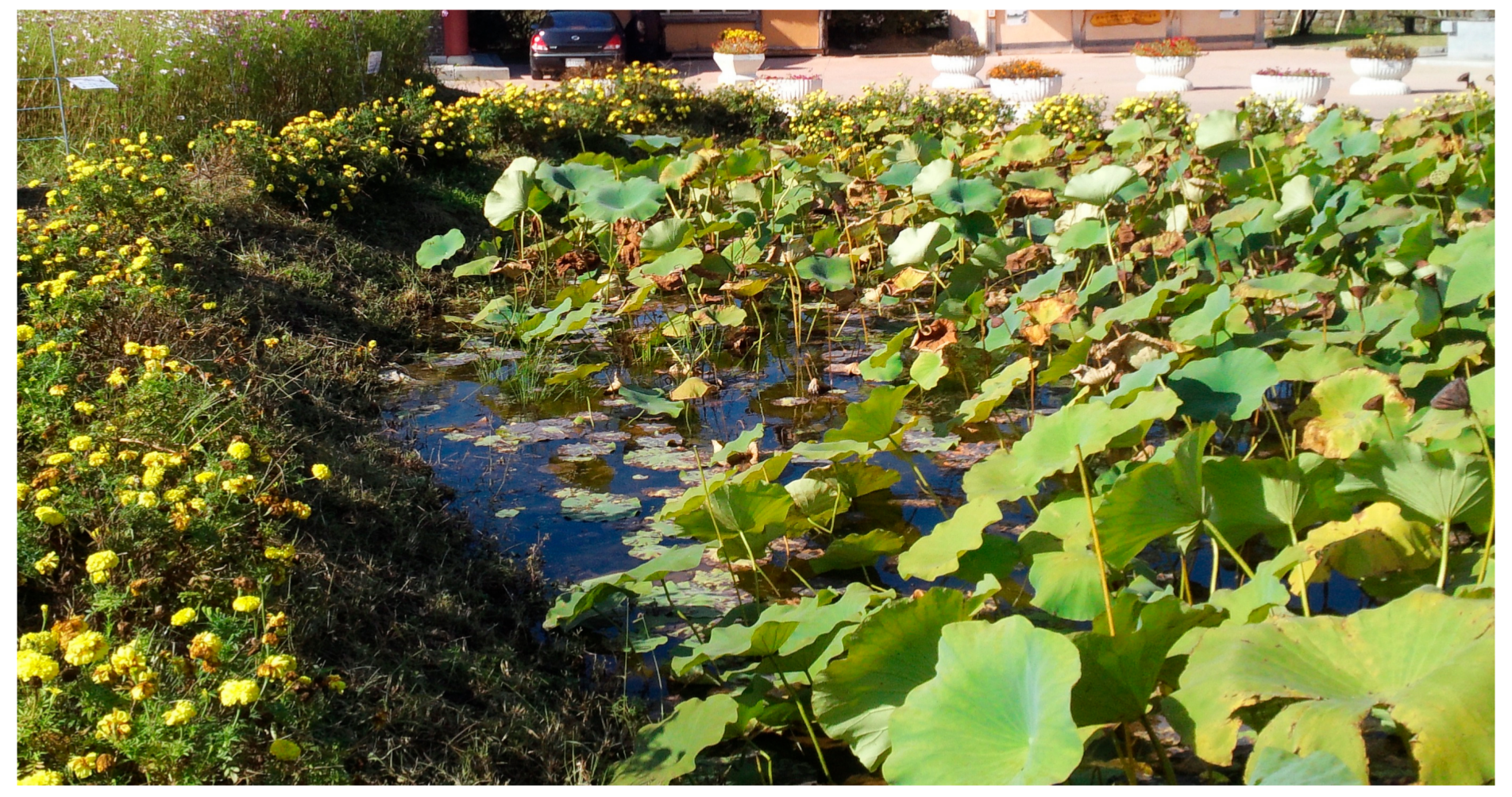Water Treatment Measures to Improve Ecological Value in Traditional Korean Villages: The Case of Oeam Village, Asan City, Korea
Abstract
:1. Introduction
2. Materials and Methods
2.1. Study Scope and Area
2.2. Research Methods
2.3. Field Surveys for Collecting Presence Data
2.3.1. Village Water Treatment Structure
Village Waterway
Village Pond
2.3.2. Village Pond Water Quality Inspection
3. Results
3.1. Analysis of Water Purification
3.2. Changes in Ecological Resources
4. Discussion
5. Conclusions
Acknowledgments
Author Contributions
Conflicts of Interest
References
- Goals of UN-Habitat. Available online: http://unhabitat.org/about-us/goals-and-strategies-of-un-habitat/ (accessed on 20 June 2017).
- Shin, S.S. A study on the environmental soundness and sustainability of Nagan walled town and Oeam traditional village. J. Korean Inst. Tradit. Landsc. Archit. 2004, 22, 27–38. [Google Scholar]
- An, B.C. Study on the Holistic Value Analysis and Efficient Use of Korean Traditional Village Bangjuk. Ph.D. Thesis, Korea University, Seoul, Korea, 2009. [Google Scholar]
- Noubactep, C. Metallic iron for water treatment: A knowledge system challenges mainstream science. Fresenius Environ. Bull. 2011, 20, 2632–2637. [Google Scholar]
- Jeong, D.S. The characteristics of water space in the spatial structure of Oeam folk village. Urban Des. 2010, 11, 23–44. [Google Scholar]
- Shin, S.S. A study on the environmental design principles and space organization of traditional villages. J. Korean Inst. Tradit. Landsc. Archit. 2000, 18, 20–31. [Google Scholar]
- Nam, S.H.; Kim, Y.K. A study on the water space in Woeam-ri folk village. J. Korean Inst. Tradit. Landsc. Archit. 2000, 18, 60–69. [Google Scholar]
- Shin, Y.H.; Chae, H.S.; Lee, E.S.; Lee, D.H.; Shin, F.S.; Yang, S.J. Landscape ecological interpretations of waterways in Oeam traditional village. Geogr. J. Korea 2011, 45, 427–438. [Google Scholar]
- An, B.C. A study on efficiency of water purification of Korean village bangjuk (dike) as a means of ecological watershed management. J. Korean Inst. Tradit. Landsc. Archit. 2012, 30, 90–100. [Google Scholar]
- Kim, H.S.; Park, J.C.; Kim, P.W. Survey on the application for the Nakan-Eupseong located at Suncheon by the classification system of environmental-friendly design factors in traditional village. J. Archit. Inst. Korea 2012, 28, 231–240. [Google Scholar]
- Kim, H.S. Analysis on the application of environmental-friendly design factors for Wol-gok traditional village located at Hwa-sun by using the classification system. J. Archit. Inst. Korea 2014, 30, 61–69. [Google Scholar] [CrossRef]
- Kim, H.S. The analysis on the application of environmental-friendly design factors for the Changpyung Samjinae village by using the classification system in the existing traditional village. J. Korean Soc. Living Environ. Syst. 2011, 18, 718–738. [Google Scholar]
- Shin, S.S. Environmental design principle, vernacular landscape, ecological network system. J. Korean Inst. Tradit. Landsc. Archit. 2003, 1, 23–35. [Google Scholar]
- Han, P.W. The environmental ecological interpretation of a traditional Korean settlement. J. Archit. Inst. Korea 1996, 12, 121–132. [Google Scholar]
- United States Environmental Protection Agency (EPA). Guidelines for Water Reuse; USAID: Washington, DC, USA, 2012. [Google Scholar]
- Zhu, W.; Niu, Q.; Zhang, R.; Ye, R.; Qian, X.; Qian, Y. Application of QUAL2K model to assess ecological purification technology for a polluted river. Int. J. Environ. Res. Public Health 2015, 12, 2215–2229. [Google Scholar] [CrossRef] [PubMed]
- Li, T.; Gao, X. Ecosystem services valuation of lakeside wetland park beside Chaohu Lake in China. Water 2016, 8, 301. [Google Scholar] [CrossRef]
- Yoo, B.K.; Kwak, J.W.; Kim, H.S.; Kim, J.G. Effectiveness analysis of constructed washland: (2) Economic valuation. J. Korean Soc. Civ. Eng. 2010, 30, 23–31. [Google Scholar]
- Byeon, C.W. An ecological restoration of treatment wetland and urban upper stream for reusing sewage treatment water. J. Korean Environ. Res. Tech. 2014, 17, 65–77. [Google Scholar]
- Lee, S.H. Evaluation of pollutants removal for treated wastewater effluent and river water by meandering constructed wetland system. J. Korean Soc. Water Wastewater 2012, 26, 131–139. [Google Scholar] [CrossRef]
- Dai, H.; Sun, T.; Zhang, K.; Guo, W. Research on rural nonpoint source pollution in the process of urban-rural integration in the economically developed area in China based on the improved STIRPAT model. Sustainability 2015, 7, 782–793. [Google Scholar] [CrossRef]
- Alvarez, S.; Asci, S.; Vorotnikova, E. Valuing the potential benefits of water quality improvements in watersheds affected by non-point source pollution. Water 2016, 8, 112. [Google Scholar] [CrossRef]
- Motsinger, J.; Kalita, P.; Bhattarai, R. Analysis of best management practices implementation on water quality using the soil and water assessment tool. Water 2016, 8, 145. [Google Scholar] [CrossRef]
- Abrahams, J.C.; Coupe, S.J.; Sañudo-Fontaneda, L.A.; Schmutz, U. The Brookside Farm Wetland Ecosystem Treatment (WET) System: A low-energy methodology for sewage purification, biomass production (yield), flood resilience and bio diversity enhancement. Sustainability 2017, 9, 147. [Google Scholar] [CrossRef]
- Wang, Z.; Yang, S.; Zhao, C.; Bai, J.; Lou, H.; Chen, K.; Wu, L.; Dong, G.; Zhou, Q. Assessment of non-point source total phosphorus pollution from different land use and soil types in a mid-high latitude region of China. Water 2016, 8, 505. [Google Scholar] [CrossRef]
- Troyer, N.D.; Mereta, S.T.; Goethals, P.L.M.; Boets, P. Water quality assessment of streams and wetlands in a fast-growing East African city. Water 2016, 8, 123. [Google Scholar] [CrossRef]
- Olguín, E.J.; Sánchez-Galván, G.; Melo, F.J.; Hernández, V.J.; González-Portela, R.E. Long-term assessment at field scale of floating treatment wetlands for improvement of water quality and provision of ecosystem services in a eutrophic urban pond. Sci. Total Environ. 2017, 15, 561–571. [Google Scholar] [CrossRef] [PubMed]
- Wang, Z.; Shi, Y.; Cheng, M.; He, C.; Zhuang, J.; Sheng, L. Purification of small-scale stagnant water in urban regions: Human-powered water lift and bank-based constructed wetland. Ecol. Eng. 2015, 83, 108–111. [Google Scholar] [CrossRef]
- Oeam Village, Asan. Cultural Heritage Association [Korea] Website. Available online: http://www.cha.go.kr (accessed on 3 December 2016).
- Ministry of Environment. Environmental Standard for Water Quality; Ministry of Environment: Incheon, Korea, 2008.
- Techonagoglus, G.; Burton, F.L. Wastewater Engineering: Treatment and Reuse; McGraw-Hill: New York, NY, USA, 1991. [Google Scholar]
- Lee, S.G.; Seo, D.C.; Choi, I.W.; Kang, S.W.; Seo, Y.J.; Park, J.W.; Heo, J.S.; Cho, J.S. Effect of plant distribution and wetland type on nutrient removal in Juam Lake Eco-Wetland. Korean Soc. Environ. Agric. 2013, 32, 336. [Google Scholar]
- Pang, J.; Feng, X.; Wang, X. Purification and utilization of garlic processing wastewater in lotus pond wetlands. Water Sci. Eng. 2014, 7, 395–402. [Google Scholar]








| Type | Detailed Information | |
|---|---|---|
| Main Items | Specifications | |
| Wetland | Water Area | 510 m2 |
| Mean Water Depth | 0.75 m | |
| Pond Circumference | 86 m | |
| Water Volume | 250–300 m3 | |
| Construction Date | 2013 | |
| Agricultural Land Area | 11,493 m2 | |
| Point of Investigation | Analysis Items | Date | |||||
|---|---|---|---|---|---|---|---|
| T-N (mg/L) | DO (mg/L) | BOD (mg/L) | COD (mg/L) | SS (mg/L) | T-P (mg/L) | ||
| Influent 1 | 3.990 | 3.8 | 11.4 | 22.7 | 216.0 | 3.130 | July 2016 |
| Influent 2 | 6.570 | 2.1 | 12.8 | 26.3 | 173.3 | 2.220 | |
| Effluent | 0.660 | 7.7 | 4.2 | 11.3 | 105.3 | 0.116 | |
| Influent 1 | 1.065 | 7.8 | 4.0 | 9.8 | 51.0 | 0.618 | August 2016 |
| Influent 2 | 3.200 | 8.2 | 5.2 | 11.0 | 13.0 | 0.652 | |
| Effluent | 0.562 | 8.4 | 1.9 | 5.5 | 17.0 | 0.491 | |
| Influent 1 | 1.047 | 7.3 | 4.1 | 9.0 | 548.0 | 0.168 | January 2016 |
| Influent 2 | 2.791 | 6.2 | 7.3 | 14.1 | 1685.0 | 0.413 | |
| Effluent | 1.001 | 8.6 | 2.7 | 5.9 | 253.0 | 0.043 | |
| Influent 1 | 10.320 | 7.1 | 10.4 | 56.0 | 130.0 | 0.566 | May 2017 |
| Influent 2 | 6.912 | 7.1 | 17.3 | 44.7 | 95.0 | 0.624 | |
| Effluent | 2.640 | 9.1 | 5.9 | 21.7 | 11.2 | 0.110 | |
| Influent 1 | 11.952 | 7.6 | 18.7 | 43.3 | 168.0 | 1.094 | June 2017 |
| Influent 2 | 10.944 | 7.1 | 28.3 | 59.6 | 74.0 | 1.334 | |
| Effluent | 2.388 | 8 | 5.9 | 16.2 | 21.3 | 0.384 | |
| Influent Average | Effluent Average | Removal Efficiency (%) | |
|---|---|---|---|
| T-N | 5.879 | 1.450 | 75.33 |
| DO | 6.430 | 8.360 | −30.02 |
| BOD | 11.950 | 4.120 | 65.52 |
| COD | 29.650 | 12.120 | 59.12 |
| SS | 315.330 | 81.560 | 74.14 |
| T-P | 1.082 | 0.229 | 78.85 |
| Ave | N | SD | Standard Error of the Mean | ||
|---|---|---|---|---|---|
| Alternative 1 | Influent T-N | 5.879 | 10 | 4.091 | 1.294 |
| Effluent T-N | 1.450 | 10 | 0.932 | 0.295 | |
| Alternative 2 | Influent DO | 6.430 | 10 | 1.949 | 0.616 |
| Effluent DO | 8.360 | 10 | 0.510 | 0.161 | |
| Alternative 3 | Influent BOD | 11.950 | 10 | 7.724 | 2.443 |
| Effluent BOD | 4.120 | 10 | 1.718 | 0.543 | |
| Alternative 4 | Influent COD | 29.650 | 10 | 19.646 | 6.213 |
| Effluent COD | 12.120 | 10 | 6.525 | 2.063 | |
| Alternative 5 | Influent SS | 315.330 | 10 | 503.795 | 159.314 |
| Effluent SS | 81.560 | 10 | 97.417 | 30.806 | |
| Alternative 6 | Influent T-P | 1.082 | 10 | 0.926 | 0.293 |
| Effluent T-P | 0.229 | 10 | 0.185 | 0.059 | |
| N | Correlation | p-Value | ||
|---|---|---|---|---|
| Alternative 1 | Influent TN–Effluent TN | 10 | 0.819 | 0.004 |
| Alternative 2 | Influent DO–Effluent DO | 10 | 0.581 | 0.078 |
| Alternative 3 | Influent BOD–Effluent BOD | 10 | 0.823 | 0.003 |
| Alternative 4 | Influent COD–Effluent COD | 10 | 0.921 | 0 |
| Alternative 5 | Influent SS–Effluent SS | 10 | 0.809 | 0.005 |
| Alternative 6 | Influent TP–Effluent TP | 10 | −0.093 | 0.799 |
| Ave | SD | Average Standard Error | 95% Confidence Interval | t | Df | p-Value | |||
|---|---|---|---|---|---|---|---|---|---|
| Lower Limit | Upper Limit | ||||||||
| Alternative 1 | Influent TN–Effluent TN | 4.429 | 3.370 | 1.066 | 2.018 | 6.839 | 4.156 | 9 | 0.002 |
| Alternative 2 | Influent DO–Effluent DO | −1.930 | 1.704 | 0.539 | −3.149 | −0.711 | −3.581 | 9 | 0.006 |
| Alternative 3 | Influent BOD–Effluent BOD | 7.830 | 6.385 | 2.019 | 3.262 | 12.398 | 3.878 | 9 | 0.004 |
| Alternative 4 | Influent COD–Effluent COD | 17.530 | 13.868 | 4.386 | 7.609 | 27.451 | 3.997 | 9 | 0.003 |
| Alternative 5 | Influent SS–Effluent SS | 233.770 | 428.777 | 135.591 | −72.959 | 540.499 | 1.724 | 9 | 0.119 |
| Alternative 6 | Influent TP–Effluent TP | 0.853 | 0.961 | 0.304 | 0.166 | 1.540 | 2.808 | 9 | 0.02 |
© 2017 by the authors. Licensee MDPI, Basel, Switzerland. This article is an open access article distributed under the terms and conditions of the Creative Commons Attribution (CC BY) license (http://creativecommons.org/licenses/by/4.0/).
Share and Cite
An, B.-C.; Park, E.-Y. Water Treatment Measures to Improve Ecological Value in Traditional Korean Villages: The Case of Oeam Village, Asan City, Korea. Sustainability 2017, 9, 1145. https://doi.org/10.3390/su9071145
An B-C, Park E-Y. Water Treatment Measures to Improve Ecological Value in Traditional Korean Villages: The Case of Oeam Village, Asan City, Korea. Sustainability. 2017; 9(7):1145. https://doi.org/10.3390/su9071145
Chicago/Turabian StyleAn, Byung-Chul, and Eun-Yeong Park. 2017. "Water Treatment Measures to Improve Ecological Value in Traditional Korean Villages: The Case of Oeam Village, Asan City, Korea" Sustainability 9, no. 7: 1145. https://doi.org/10.3390/su9071145
APA StyleAn, B.-C., & Park, E.-Y. (2017). Water Treatment Measures to Improve Ecological Value in Traditional Korean Villages: The Case of Oeam Village, Asan City, Korea. Sustainability, 9(7), 1145. https://doi.org/10.3390/su9071145





